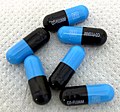Ampicillin/flucloxacillin: Difference between revisions
page |
cite beta-lactam |
||
| Line 6: | Line 6: | ||
| type = combo |
| type = combo |
||
| component1 = Ampicillin |
| component1 = Ampicillin |
||
| class1 = [[β-lactam antibiotic|β-lactam antibiotic (penicillin)]]<ref name=Tidwell>{{Cite book|last=Tidwell|first=Thomas T.|url=https://books.google.com/books?id=VDXbDgAAQBAJ&newbks=0&printsec=frontcover&pg=PA106&dq=Ampicillin/flucloxacillin&hl=en|title=Beta-Lactams: Novel Synthetic Pathways and Applications|date=2017|publisher=Springer|year=|isbn=978-3-319-55621-5|editor-last=Banik|editor-first=Bimal K.|location=Edinburg, Texas|pages=106|language=en|chapter=Beta-Lactams from ketene- Imine Cycloadditins: An Update}}</ref> |
|||
| class1 = [[β-lactam antibiotic|β-lactam antibiotic (penicillin)]] |
|||
| component2 = Flucloxacillin |
| component2 = Flucloxacillin |
||
| class2 = [[β-lactam antibiotic|β-lactam antibiotic (penicillin)]] |
| class2 = [[β-lactam antibiotic|β-lactam antibiotic (penicillin)]]<ref name=Tidwell/> |
||
<!--Clinical data--> |
<!--Clinical data--> |
||
| tradename = |
| tradename = |
||
Revision as of 18:56, 21 December 2020
 | |
 | |
| Combination of | |
|---|---|
| Ampicillin | β-lactam antibiotic (penicillin)[1] |
| Flucloxacillin | β-lactam antibiotic (penicillin)[1] |
| Clinical data | |
| Routes of administration | Oral, intravenous |
| ATC code | |
| Identifiers | |
| CAS Number | |
| ChemSpider | |
| UNII | |
| CompTox Dashboard (EPA) | |
| (verify) | |
Ampicillin/flucloxacillin (INNs) also known as co-fluampicil (BAN), and sold under the tradename Magnapen, is a combination drug of the two β-lactam antibiotics, ampicillin and flucloxacillin, both in equal amounts, available in a capsule and as a liquid, both taken by mouth, and as a formulation which can be given by injection into muscle or vein.[2][3]
It is used to treat infections before the laboratory results confirm the causative organism.[4] Side effects include stomach or bowel upsets.[2] It should not be taken by people allergic to penicillin.[2][5]
Indication
The combination of ampicillin/flucloxacillin is typically given before laboratory results are known. Conditions where it maybe used include infections in the chest, ear, throat, skin and soft tissue. It can be given in septic abortion, puerperal fever and in people receiving immunosuppressive treatments, and to prevent infection after surgery.[4]
Formulations
It is available in a capsule and a liquid, both taken by mouth, and as a formulation which can be given by injection into muscle or vein.[2][6]
Capsules contain 250 mg of each component, the syrup 125/125 mg per spoon, and the powder for reconstruction for intravenous injection 250/250 mg.[2]
-
Co-fluampicil capsules and container (UK)
-
Co-fluampicil capsules (UK)
Side effects and contraindications
Side effects are the same as per the individual components, with stomach or bowel upset from the flucloxacillin being the most common.[2]
Both parts are members of the penicillin family of antibiotics, so should not be taken by people allergic to penicillin.[2] The combination is contraindicated in people with a history of flucloxacillin-associated jaundice/hepatic dysfunction and in people with porphyria.[4]
See also
References
- ^ a b Tidwell, Thomas T. (2017). "Beta-Lactams from ketene- Imine Cycloadditins: An Update". In Banik, Bimal K. (ed.). Beta-Lactams: Novel Synthetic Pathways and Applications. Edinburg, Texas: Springer. p. 106. ISBN 978-3-319-55621-5.
- ^ a b c d e f g "5. Infection". British National Formulary (BNF) (80 ed.). BMJ Group and the Pharmaceutical Press. September 2020 – March 2021. p. 582. ISBN 978-0-85711-369-6.
{{cite book}}: CS1 maint: date format (link) - ^ "Magnapen". www.mims.co.uk. Retrieved 18 December 2020.
{{cite web}}: CS1 maint: url-status (link) - ^ a b c "Co-fluampicil capsules". Drugs.com. Retrieved 18 December 2020.
- ^ "Co-fluampicil for bacterial infections. Side effects and dosage". patient.info. Retrieved 18 December 2020.
{{cite web}}: CS1 maint: url-status (link) - ^ Gray A, Wright J, Goodey V, Bruce L (2010). Injectable Drugs Guide. Pharmaceutical Press. ISBN 978-0-85369-787-9.


